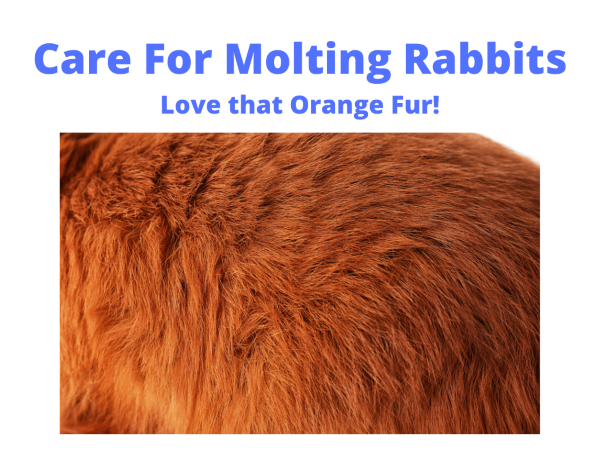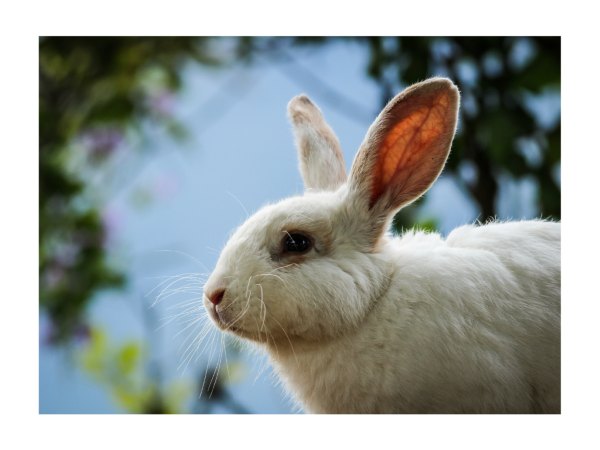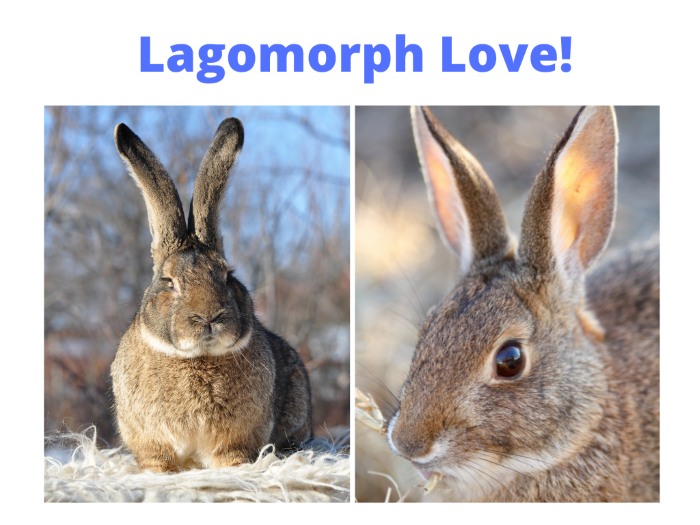Many new rabbit owners become concerned when they see their rabbits begin to shed… and shed… and shed. They see clumps of hair, fur and wool literally falling off of their rabbits and ask, “Is my rabbit OK?”
Yes, rabbits naturally molt their fur coats several times each year. The heaviest molt is typically in the spring as bunnies shed their winter coat. You can help your rabbit molt and reduce the amount of hair it ingests by brushing your bunny daily during the
2 to 4 week molt.
Here at Hobby Farm Heaven we understand why bunnies molt (moult) and in this post we explain this natural process in depth. For the healthy bunny, shedding (which is also known as molting or moulting), is the natural shedding of coats of hair, just as your dog sheds hair…
Yes, molting rabbits is a natural seasonal cycle and molting in rabbits is normal.
Ask me about the endless wheelbarrows full of hair that our Golden Retriever and rabbits shed! Like us, you can opt help your bunny or other pets’ shedding process; and perhaps speed it up if you wish.
Some rabbits moult until there are patches of bare skin visible, don’t worry! The hair will begin to grow back right away. However, if your rabbit has bare spots of skin with no fur for more than 2 weeks, then it is stressed, battling an illness or pest infestation and you should consult with your veterinarian right away.
Did you know that rabbit hair is also spun to make soft, beautiful sweaters!
Read On!
Why Is My Rabbit Shedding So Much?
Your rabbit is very likely going through a molt in which much, if not all, of it’s fur will fall out as new fur grows in to replace it. Rabbits molting is natural; it is not a disease, it is a natural process that benefits the rabbit. Read on to learn more.
Do Rabbits Shed Hair? Do Rabbits Shed Their Fur?
Yes, Rabbits shed their hair. More precisely this is a molt. The rabbits molts for the same reasons that chickens (and many types of birds) and dogs molt.
The rabbit molts “old” hair, fur, wool to prepare the way for the new hair, fur, wool.
When Do Rabbits Molt?
This interesting and educational National Geographic Snowshoe Hare Molt article points out that snowshoe hares strategically molt their white winter coat in the early summer as a brown summer coat grows in.
Similarly, as the fall days get shorter and winter approaches, the snowshoe hare sheds his brown summer coat as his white winter coat grows in. Rabbits are a food source for many forest, prairie and tundra predators. This adaptation allows the hare to blend into its seasonal surroundings – a defensive adaptation known as background camouflage.
How Often Do Rabbits Molt? How Often Do Rabbits Shed?
MOLT (moult) — The act or process of shedding or changing the fur. The baby or nest fur is shed at two months, and the first natural coat of fur is fully developed at four to six months.
There is some widespread disagreement regarding how often rabbits molt. Speaking more broadly, rabbits molt about every 3 months. Every other molt will likely be mild and you may not even notice it. The more noticeable molts are the pre-winter and post-winter molts or sheds. Pre-winter the bunny is shedding its shorter and somewhat thinner summer coat. Post-Winter, the bunny is shedding its longer and thicker winter coat. Again, sometimes the seasonal coats are different colors. This is all very natural.

Proper Care for Molting Rabbits
Owners can definitely help a rabbit move through a molt and not get “stuck in a molt”. Here are several things we do to assist our rabbits during a molt:
- Brush and Pluck Your Rabbit – to remove hair & reduce ingestion of hair when rabbit grooms itself
- Feed Plenty of Hay and Water – to promote digestive motility
- Ensure Exercise – to promote digestion and removal of hair and general health and well being
Should I Brush and Pluck My Rabbit When It Is Molting?
If the rabbit is in a molt, then it is helpful to brush and pluck the rabbit daily. Rabbits have very sensitive skin, however plucking their hair during a molt will not hurt them. In fact, we have found that our rabbits enjoy this special grooming!
Brushing and plucking during a molt helps ensure that the rabbit’s coat stays nice and clean and that excess hair does not get tangled and matted. More importantly, brushing and plucking during a molt helps minimize the amount of hair that the molting rabbit ingests as it grooms itself.
Reducing the amount of hair ingested is very important because rabbits are fastidious about cleaning themselves! They do this by licking and pawing, similar to cats.
As a result, like cats, they inevitably ingest a fair amount of their hair. But unlike cats, rabbits are not able to cough up hairballs or furballs. Rabbits must pass the hair and fur that they ingest through their digestive tract.
You will undoubtedly note some rabbit feces that seem to be strung together by hair. These are commonly called “strings-of-pearls”, they are fecal pellets strung together by intertwined hairs. These hairs have been ingested by the rabbit grooming itself and “strings of pearls” is perfectly natural.
We’ve established that during a molt, your rabbits are likely to ingest more hair than usual. This is a significant risk for Rabbits as hair does not break down or digest well in the rabbit’s gut. Your goal is to reduce the amount of ingested hair, particularly during molt, because balls of desiccated food and hair can form in the rabbit’s digestive system and cause blockages.
If a rabbit has a blockage, it will not eat. And rabbits that are not eating and pooping become very sick and can quickly spiral down, worsening to the point of death fairly quickly.

Feed Unlimited Quality Hay and Water To Molting Rabbits
Owners can help prevent these digestive blockages, and promote healthy and continual intestinal motility by ensuring that rabbits have full access to unlimited quality hay (fiber) and water.
During a molt you may also consider reducing treats so that even more hay is consumed!
Additionally, many rabbit experts argue that water bowls are better than the upside down sipper bottles. Lapping from a bowl (or creek) is a more natural action for the rabbit so it will drink more water from a bowl.
The reality is also that rabbits spill and sometimes soil water bowls. We advocate for providing both a bowl and a sipper bottle. Remember, if your rabbits are outside during freezing temperatures, then you may have to check both the water bowl and the sipper bottle throughout the day to ensure they have access to water.
Molting or not, if your rabbit is not eating then consider it an emergency and consult your veterinarian immediately. In addition, the National Angora Rabbit Breeders Association guide notes that feeding Papaya extract to your rabbits, as directed by your veterinarian, is another way to help prevent hair related blockages during a molt. The enzyme helps break down the hairs in the rabbit’s digestive system. Papaya enzyme may be found in your local drug store, or via your vet.
Exercise For Molting Rabbits
Exercise helps digestive motility. Motility reduces the chances of a hairball blockage during molting when rabbits are ingesting more hair than usual. Exercise also helps the rabbit move through the molt, pun intended! Yes, hopping around will help the old hair and fur fall out, making way for the new hair and fur. Lastly, some exercise generally benefits your healthy bunny and makes your bunny happier.

Do Rabbits Shed When Stressed
Yes, some rabbits may manifest stressors by shedding fur. This stress induced shedding is not to be confused with a natural molting of fur.
The rabbit may also manifest other health issues such as poor diet, disagreements with other rabbits in the hutch, pest infestation etc., by shedding hair.
Why Is My Rabbit Losing Hair?
MediRabbit explains that some rabbits lose hair due to vitamin deficiencies. One tell-tale sign of vitamin deficiency is orange colored points of hair on a dark fur.
Further, some female rabbits get confused, think they are pregnant and begin to pluck out some of their hair to form a nest for baby rabbits. Such a rabbit is called a pseudo-pregnant female. Additionally, the rabbit that is losing hair, but is not molting, may be a victim of an infestation of a common rabbit skin parasite known as “Walking Dandruff”.
Walking Dandruff, or Cheyletiellosis, is actually caused by the cheyletiellosis mite. The mite does not burrow in the skin but walks across the rabbit’s sensitive skin and causes large white flakes of skin to flake off.
VCA Hospitals, a national network of animal hospitals run by veterinarians, explains that:
- “The parasite often shows up in young animals or older debilitated animals, especially if they can’t properly groom themselves because of teeth problems or arthritis or other mobility issues.
- Walking dandruff also happens more frequently in longer haired rabbits.”
The mite is highly transferable – meaning it will try to infest your other pets, such as dogs. The mite may also spread to rugs, beddings, towels, blankets, drapes, etc in your home. The remedy for your rabbit is to see your local rabbit veterinarian for a thorough examination and treatment recommendation.
Do Rabbits Shed A Lot? Why Is My Rabbit Molting So Much?
Unfortunately, some rabbits seem to be continuously molting throughout the year. There are several possible explanations for this almost constant molting:
- Extensive in-breeding may cause problems with normal reactions to seasonal length of day.
- Artificial lighting may cause problems with the rabbit’s natural crepuscular and circadian cycles
- Artificial Indoor heating and air conditioning may cause molting issues for house rabbits
Why Do Rabbits Molt
Rabbits molting is natural and some rabbits molt more than others.
A rabbit molts for the same reason that chickens molt their feathers – it is nature’s way of renewing the rabbits hair. Molting in rabbits is often a transition from a heavier winter coat to a lighter summer coat, or vice-a-versa. As discussed above, for some rabbits the molting facilitates a strategic color change or camouflage that is fundamental to the survival of the species.
Animals molt to renew feathers, hair, skin or exoskeleton.

Is My Rabbit Molting Excessively?
Some rabbits molt “all at once” and it may seem like they are molting excessively or too much.
Rabbit fur is often fluffy as it falls off the rabbit during a molt. When rabbits molt there can be what seems like enough fur to stuff a mattress. The volume of hair can be alarming.
Check this out: Angora rabbits molt a much sought after wooly hair. Angoras are known for their wooly fur that is said to be seven times warmer than sheep wool. To give you an idea of how much fur can result from a molt, the Angora Rabbit Breeders Association guide states that:
“English, French and Satin Angoras can yield 10-16 ounces (0.28 – 0.45 Kg) of wool per year; however Giants can produce up to 28 – 40 ounces (0.8 – 1.13 Kg) per year.”
And it is said that about 6 ounces of rabbit fur wool are needed to create a shoulder shawl.
How Long Do Rabbits Shed? How Long Do Rabbits Molt?
Some rabbits molt very quickly (as in 2 or 3 days), and other rabbits seem to molt slowly over as many as 8 weeks, the typical rabbit molting period is 2 to 4 weeks.
Do Rabbits Shed In The Winter?
Yes, rabbits shed a winter coat; rabbits lose their winter fur. In fact, bunnies will typically go through their heaviest molt (or shed) as winter finishes.
Molting the heavy winter coat makes way for the lighter summer coat and possibly a change of color to camouflage with the colors of the local summer environment.
How Do Rabbits Know When To Molt?
The natural triggers for the end-of-winter molt are the days getting longer and warmer. Conversely, the natural triggers for the end-of-summer molt are the days getting shorter and colder.

Do Pet Rabbits Shed?
Yes, all healthy bunnies molt (or shed). As noted above, pet rabbits that are house rabbits may or may not have as clearly defined molts as rabbits living outside.
It is said that some house rabbits seem to have longer and less defined molts than outdoor pet rabbits.
This may be because house rabbits do not experience the same natural molting triggers that rabbits living outside experience. Naturally, house rabbits crepuscular and circadian cycles are influenced by indoor artificial light and by the indoor heat and air conditioning.
Do Rabbits Shed Or Molt?
Spoken casually, shedding and molting are interchangeable. However, officially rabbits molt. The official terminology for rabbits is molt or molting.
Do Rabbits Get Grumpy When They Molt?
Many owners report that their pet bunnies seem less playful and even grumpy when they are molting. We at Hobby Farm Heaven have not noticed our rabbits being grumpy when they molt.
What Kinds Of Rabbits Molt or Shed?
- Do Rex Rabbits Shed: Yes, Rex rabbits shed or molt, just the same as any other rabbit.
- Do Mini Rex Rabbits Shed: Yes, Mini Rex rabbits shed and molt similar to other rabbits.
- Do Netherland Dwarf Rabbits Shed: Yes, even the little Netherland Dwarf rabbits molt.
- Do Lionhead Rabbits Shed A Lot: Yes, the mighty Lionhead rabbit molts.
- Do Lop Eared Rabbits Shed: Yes, the Lop and Mini Lop rabbits molt.
When Do Rabbits Stop Molting?
A healthy rabbit never stops molting. In old age, the molting may become a bit spotty, but even old rabbits molt.
Do Indoor Rabbits Molt
Yes, indoor or house rabbits molt. However, their natural triggers for molting such as change in hours of daylight and temperature may be a bit confused by indoor artificial lighting and indoor climate control.
When Do Rabbits Start Molting? Do Baby Rabbits Molt?
Baby rabbits molt their baby fur or nest fur at about 2 months.
How Do Rabbits Molt?
Molting in rabbits usually show a progression from the head to the rear. Meaning that the molting often, but not always, starts on the head and then continues rear-ward toward the tail.
Best 3 minute video on Molting Rabbits – Info from the great resource at www.Rabbit.Org.
.
.
Great video of Grooming a Molting bunny –
along with bonus footage for trimming nails and cleaning scent glands!
.
.
Another Video of Molting Rabbit Being Brushed and Plucked
.
Frequently Asked Questions Related To Do Rabbit Molt
What Other Animals Molt or Shed?
All arthropods including spiders, insects and crustaceans molt. Birds, dogs, cats and snakes molt or shed as well.
Does rabbit molting make bald patches?
Yes, a molting rabbit may have some bald patches of skin. The new fur and hair should be visible within 10 to 14 days. If new fur does not grow, then consult with your veterinarian.
Rabbit Molting and Not Eating?
If a rabbit is not eating, then contact your veterinarian immediately.
Final Thoughts on Rabbits Molting?
All healthy rabbits molt, some heavily and some lightly. Rabbit molting is a natural adaptation in rabbits and can result in some temporary bald patches.
Be aware that as rabbits meticulously groom themselves, they ingest more fur during a molt and are at greater risk of having a hair related blockage in their digestive system. To combat this and keep their digestive system working properly during a molt you may do the following:
- Brush and pluck your rabbit daily – will help the molt progress and help minimize the amount of hair that your rabbit ingests.
- Ensure plenty of hay and water for molting bunnies.
- Encourage and engage in plenty of exercise for your rabbit, especially during a molt.
As always, If your rabbit stops eating or pooping, then consult your vet immediately.
Molting rabbits are not sick, however various stressors, such as mites, a change in diet, or a vitamin deficiency may also cause a rabbit to shed fur. If you observe or suspect any health or temperament irregularities in your rabbit, then don’t hesitate to contact your local rabbit vet.
Long hair rabbits like Angoras and Lops provide hair that can be spun into a premium yarn and then used to create beautiful beautiful, warm sweaters.
Here’s a post about long hair rabbit breeds: Long Hair Bunnies

